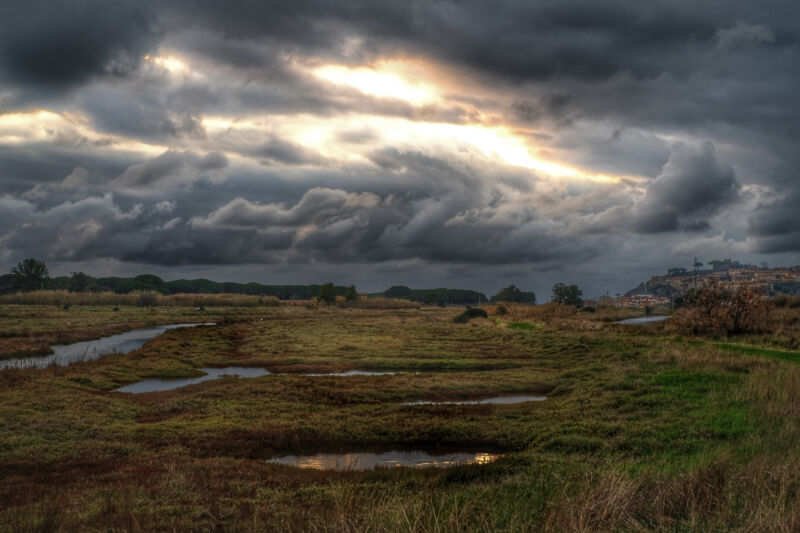

Supreme Court limits the EPA’s authority under the Clean Water Act
source link: https://arstechnica.com/tech-policy/2023/05/supreme-court-limits-the-epas-authority-under-the-clean-water-act/
Go to the source link to view the article. You can view the picture content, updated content and better typesetting reading experience. If the link is broken, please click the button below to view the snapshot at that time.
Not all wetlands —
Supreme Court limits the EPA’s authority under the Clean Water Act
Court limits regulations to wetlands that directly connect to bodies of water.
John Timmer - 5/25/2023, 7:55 PM

On Thursday, the US Supreme Court issued a ruling that severely limits the Environmental Protection Agency's ability to regulate pollution under the Clean Water Act. The ruling applies to wetlands that are connected to bodies of water that fall under the Clean Water Act's regulatory scheme, with the court now ruling that those connections need to be direct and contiguous for the act to apply. This would remove many wetlands separated by small strips of land—including artificial structures like levees—from oversight by the EPA.
The decision is a somewhat unusual one in that all nine justices agree that the people who originally sued the EPA should prevail. But there was a very sharply worded 5-4 disagreement over what the word "adjacent" means.
Whose waters are these?
The Clean Water Act was a major piece of environmental regulation due to the sometimes horrific pollution prevalent in the early 1970s. Its text applies regulations to the "waters of the United States," a term that has proven sufficiently vague that it has been the subject of various lawsuits and federal regulatory policies over the years. Several geographic features—seasonal streams, human-made water features, and marshlands without a direct connection to rivers—have all been subject to dispute.
Even the Supreme Court found the issue difficult. In one of the more relevant cases, the court had a 4-4-1 split regarding the issue of whether wetlands without a direct connection to open waters were subject to regulation. Anthony Kennedy, who was the party of one, determined that there had to be a "significant nexus" connecting the two, a phrase that was also a subject of continual debate.
Against that backdrop, the relevant federal agencies (the EPA and Army Corps of Engineers) have pursued rulemaking under different interpretations of "significant nexus," with more expansive ones prevailing under Democratic presidencies. The Trump administration's attempt to limit the scope of regulations was thrown out by a court in 2021. The Biden administration's replacement only took effect this year.
AdvertisementBrewing in the background since 2007 was a case called Sackett v. EPA. The Sacketts owned property near an Idaho lake and filled in some wetlands to build a house on the property. The EPA, noting that the wetlands drained into the lake via a nearby ditch, ordered the couple to restore the property to its original condition. The Sacketts sued, leading to the case that was before the Supreme Court.
Logic games
The entire court agrees that the connection between the Sacketts' property and the lake is too tenuous for it to fall under the "waters of the US" category, so the EPA has no regulatory authority. But a five-Justice majority used the case as an opportunity to throw out the "significant nexus" standard and craft a rule that severely limits the wetlands that can be regulated by the EPA—to the point where it's now more restrictive than even the Trump administration had planned. Under the new ruling, the Clean Water Act only applies to wetlands that are contiguous with open water, where it's difficult to determine where the wetland ends and the river or lake begins.
To do so, the majority had to struggle with the text of the law, which explicitly covers "adjacent" wetlands. In the ruling, this was done by noting that "adjacent" could have multiple definitions and identifying other areas of the Clean Water Act that, when combined, provided a more stringent definition of "adjacent." In practice, this looked a lot like playing a logic game, with the ruling literally defining the relevant wetlands using the phrase “A minus B, which includes C.”
The majority also dismisses a later amendment to the Clean Water Act that seemingly uses a more expansive definition of adjacent as "a relatively obscure provision."
Justices Thomas and Gorsuch, while concurring with these limitations, argue that the court isn't going far enough because it isn't completely crippling the Clean Water Act's scope. Making reference to colonial-era English common law and the Steamboat Act of 1838, they argue that Congress only has constitutional authority over bodies of water that can be used for trade. In this view, most of the water in the US doesn't count.
As Thomas and Gorsuch note, this view would exclude congressional authority over interstate commerce like the sale of fish or recreation by out-of-state residents. That has been well outside the judicial mainstream since around the time of the New Deal. But an originalist can dream, I guess.
Page:
Recommend
About Joyk
Aggregate valuable and interesting links.
Joyk means Joy of geeK